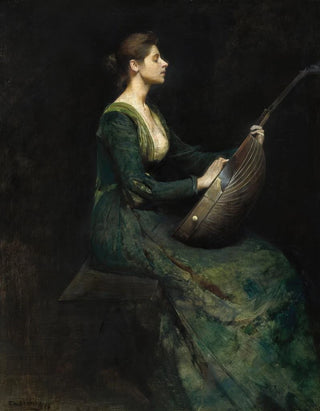Art print | Dame au luth - Thomas Wilmer Dewing


View from behind

Frame (optional)
Reproduction Dame au luth - Thomas Wilmer Dewing – Engaging Introduction
At the heart of early 20th-century artistic expression, "Dame au luth" by Thomas Wilmer Dewing stands as an iconic work, capturing the essence of a time when beauty and melancholy intertwined with delicacy. This painting, evoking an intimate atmosphere, immerses us in a world of serenity and contemplation. The female figure, enveloped in a halo of soft light, appears to play a silent melody, inviting the viewer to delve into her universe. Every detail of this piece, from textures to colors, reflects meticulous craftsmanship and rare artistic sensitivity.
Style and uniqueness of the work
The uniqueness of "Dame au luth" lies in its ability to blend realism with an almost dreamlike approach. Dewing, master of portraiture and intimate scenes, uses delicate nuances to depict the woman's skin, creating a striking contrast with the surrounding shadows. The composition is carefully orchestrated, where the posture of the lady and the instrument she holds become narrative elements in their own right. The luth, a symbol of music and harmony, is not only an accessory but also an extension of her being, reinforcing the idea that art and music are inseparable. Pastel colors, combined with subdued lighting, envelop the scene in a dreamlike atmosphere, showcasing Dewing's ability to transcend the everyday and touch the eternal.
The artist and his influence
Thomas Wilmer Dewing, a central figure of the American aesthetic movement, left his mark on his era through a deeply personal approach to art. Influenced by the Pre-Raphaelites and symbolism, he moved away from academic conventions to explore themes such as beauty, nature, and solitude. His portraits of women, often bathed in soft light, reflect a fascination with femininity and spirituality. Dewing does not merely paint figures; he creates atmospheres and palpable emotions that resonate with the viewer. His work paved the way for many artists, inspiring generations to explore more introspective styles.

Matte finish

View from behind

Frame (optional)
Reproduction Dame au luth - Thomas Wilmer Dewing – Engaging Introduction
At the heart of early 20th-century artistic expression, "Dame au luth" by Thomas Wilmer Dewing stands as an iconic work, capturing the essence of a time when beauty and melancholy intertwined with delicacy. This painting, evoking an intimate atmosphere, immerses us in a world of serenity and contemplation. The female figure, enveloped in a halo of soft light, appears to play a silent melody, inviting the viewer to delve into her universe. Every detail of this piece, from textures to colors, reflects meticulous craftsmanship and rare artistic sensitivity.
Style and uniqueness of the work
The uniqueness of "Dame au luth" lies in its ability to blend realism with an almost dreamlike approach. Dewing, master of portraiture and intimate scenes, uses delicate nuances to depict the woman's skin, creating a striking contrast with the surrounding shadows. The composition is carefully orchestrated, where the posture of the lady and the instrument she holds become narrative elements in their own right. The luth, a symbol of music and harmony, is not only an accessory but also an extension of her being, reinforcing the idea that art and music are inseparable. Pastel colors, combined with subdued lighting, envelop the scene in a dreamlike atmosphere, showcasing Dewing's ability to transcend the everyday and touch the eternal.
The artist and his influence
Thomas Wilmer Dewing, a central figure of the American aesthetic movement, left his mark on his era through a deeply personal approach to art. Influenced by the Pre-Raphaelites and symbolism, he moved away from academic conventions to explore themes such as beauty, nature, and solitude. His portraits of women, often bathed in soft light, reflect a fascination with femininity and spirituality. Dewing does not merely paint figures; he creates atmospheres and palpable emotions that resonate with the viewer. His work paved the way for many artists, inspiring generations to explore more introspective styles.






